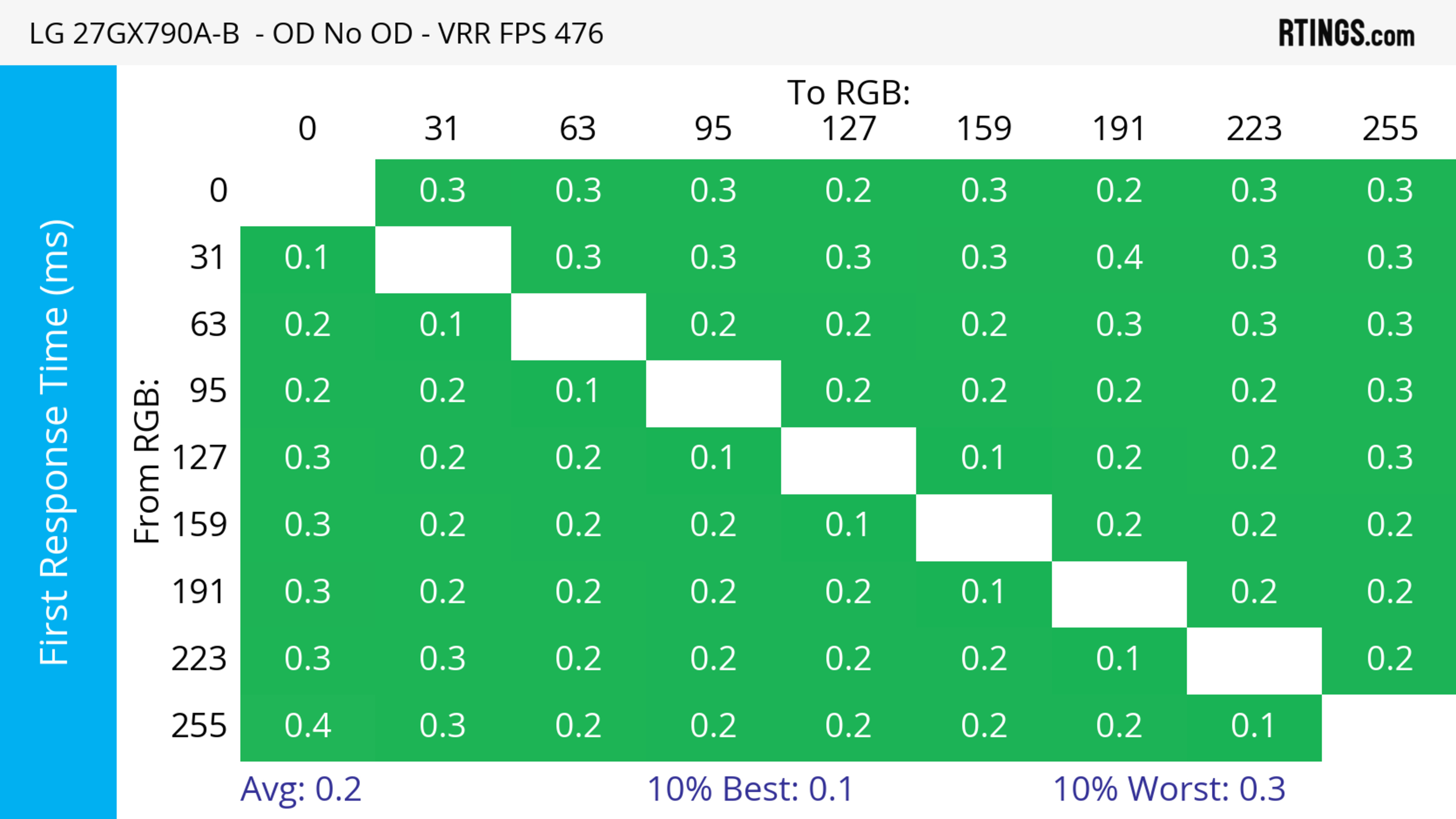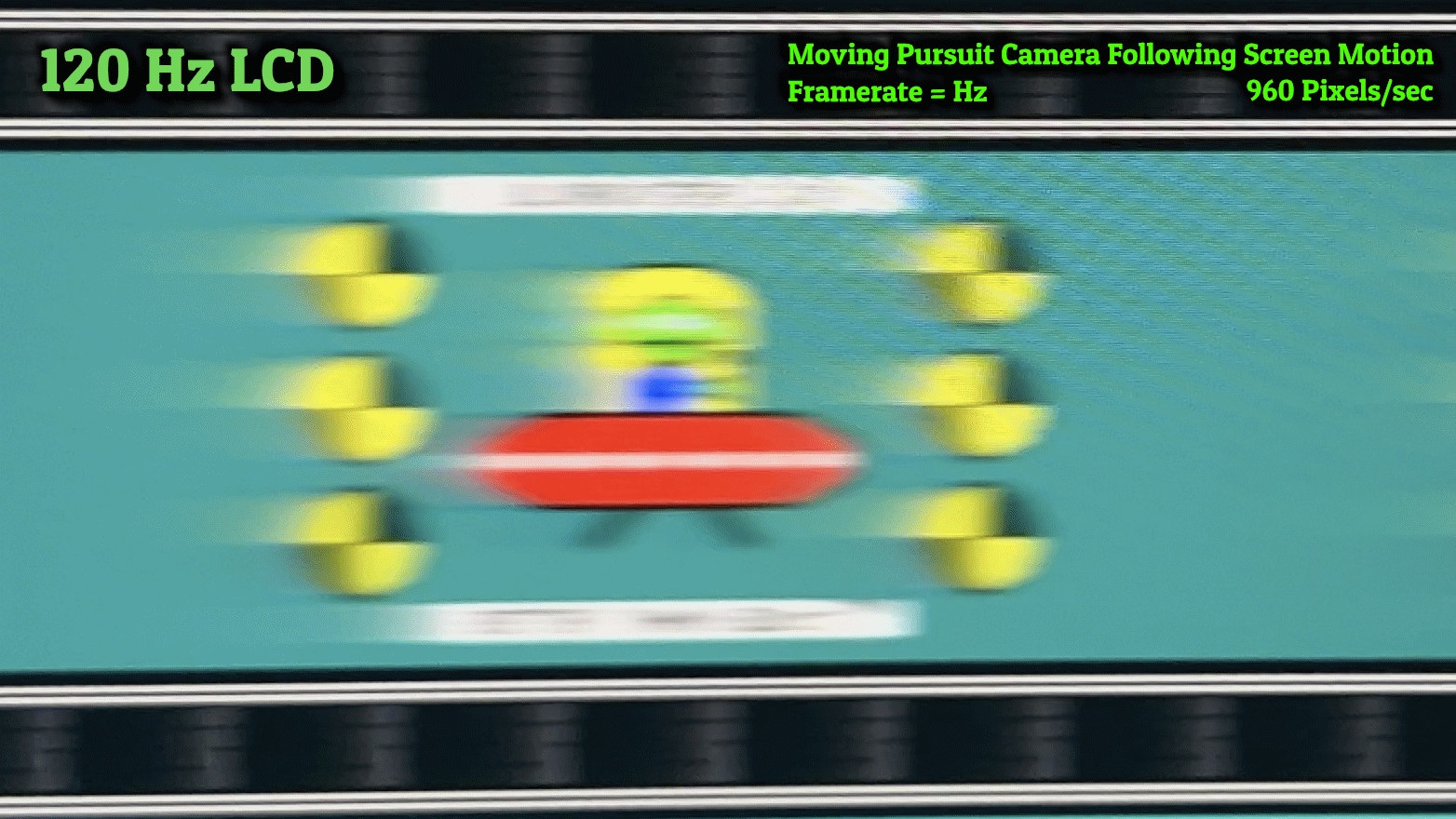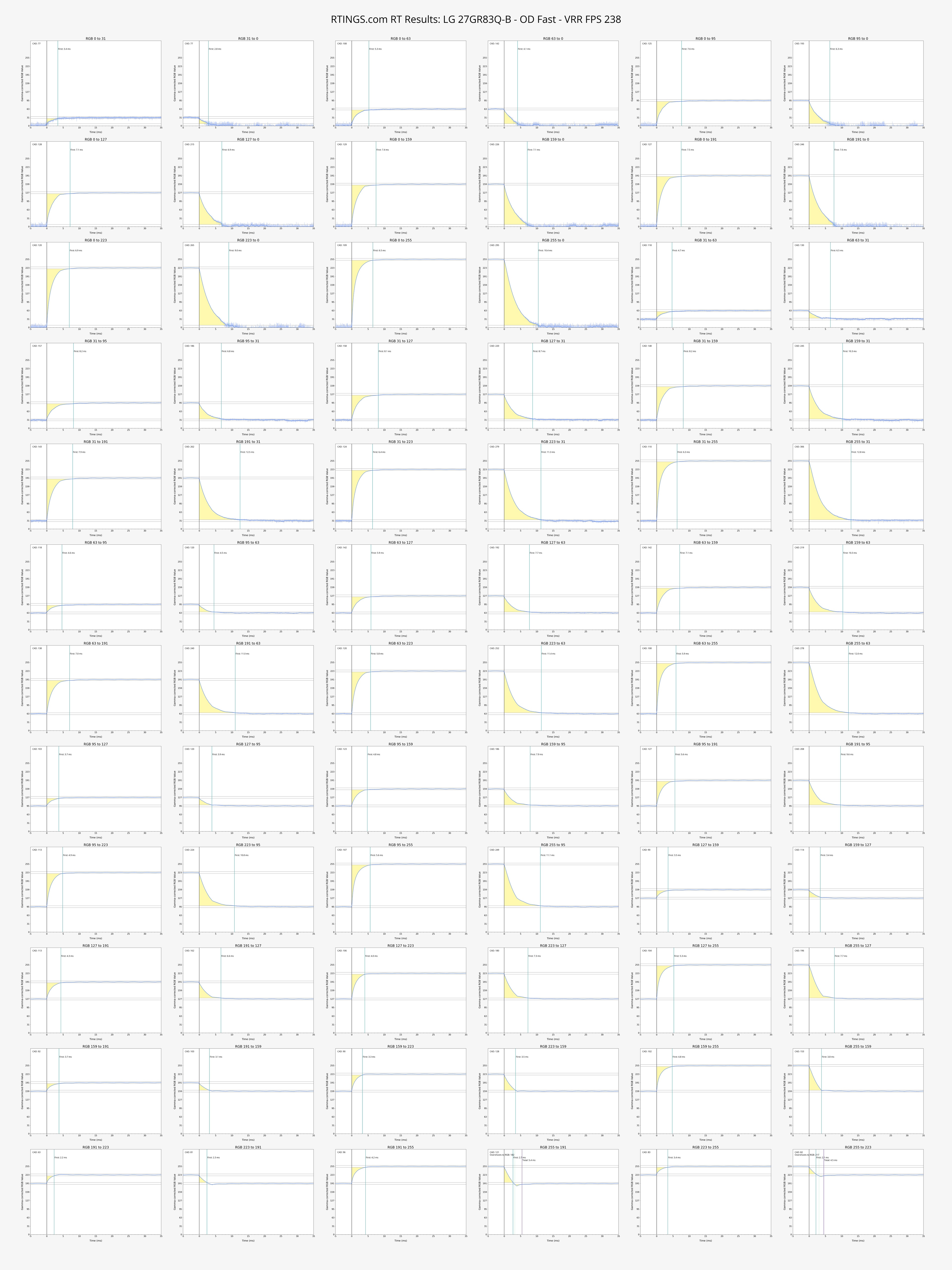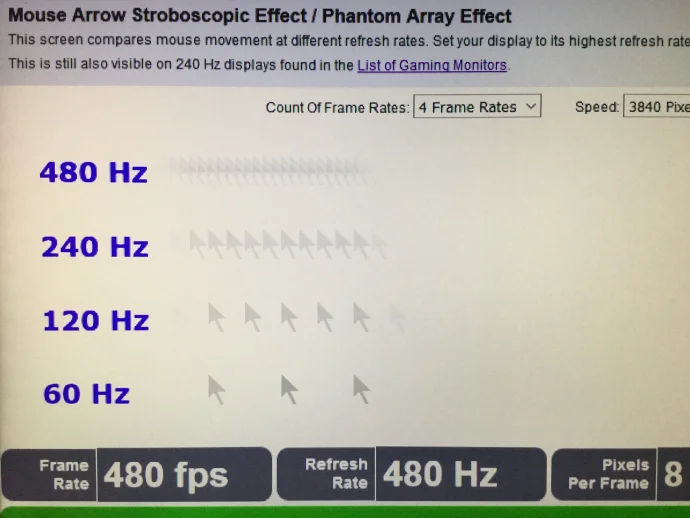could the new 720p 720hz oled reasonably have been 720p 1080hz?
-
purplemelon1
- Posts: 71
- Joined: 16 Nov 2024, 04:13
could the new 720p 720hz oled reasonably have been 720p 1080hz?
There are two reasons the 1440p 540hz oleds could have it. Stroboscopic effects and maybe input lag.
From my understanding of the road to 1000hz article, there can not be less than 1 pixel of blur per frame. Meaning the resolution bottlenecks the amount of info a refresh rate can show. Does this apply to the source/render rather than a hard bottleneck on the resolution of the hardware? If so then it would mean that stroboscopic effect can be reduced by going with a frame rate above the resolution.
The second reason is they could have cut down on lag even if just by 0.5ms. Currently even the sony m10s 480hz has 2ms midscreen, 4ms lag full screen. So maybe not.
They would need to increase the voltage reducing the lifespan of the monitor. I understand if they decided it's not worth it. Maybe it's switching down to 1440p 360hz to create 720p 720hz. Is it even worth wondering about. Probably not. ~they could have done 720p 960hz though.
From my understanding of the road to 1000hz article, there can not be less than 1 pixel of blur per frame. Meaning the resolution bottlenecks the amount of info a refresh rate can show. Does this apply to the source/render rather than a hard bottleneck on the resolution of the hardware? If so then it would mean that stroboscopic effect can be reduced by going with a frame rate above the resolution.
The second reason is they could have cut down on lag even if just by 0.5ms. Currently even the sony m10s 480hz has 2ms midscreen, 4ms lag full screen. So maybe not.
They would need to increase the voltage reducing the lifespan of the monitor. I understand if they decided it's not worth it. Maybe it's switching down to 1440p 360hz to create 720p 720hz. Is it even worth wondering about. Probably not. ~they could have done 720p 960hz though.
Re: could the new 720p 720hz oled reasonably have been 720p 1080hz?
Think of it from this perspective:
The "law" isn't an axiom, it's a definition of 1 individual (Chief) based on certain limitations surrounding hardware & human physiology.
The actual end goal to emulate analog reality with digital display is +4000FPS @ +4000Hz
Read more about this in this & this article
This is to blend the discrete digital sample rate (refresh rate) into analog-like motion (eliminating/alleviating stroboscopic effect), while also maintaining sharp dynamic content handling (good eye-tracked motion quality).
Now, as you can notice, the hardware & user app software (games) we have is not anywhere near capable to run at these monstrous frame rates & refresh rates.
This is why, as a band-aid, LCD's with backlight strobing & good HW BFI (which doesn't exist yet) are still viable options to have in a display.
Though sadly, LCD's with backlight strobing are crippled in adjustability to achieve this MPRT target (~0,25ms)
As for your OP question, yes, they've clearly segmented this display to sell the higher Hz capable panel later on.
The 1280x720@720hz@10-bit mode is within the HDMI 2.1 FRL5 bandwidth
DP2.1 UHBR20 has enough bandwidth for ~1200Hz without the use of DSC at all.
See this calculator to verify
There's no technological limitation stopping them from 1000Hz OLED.
See this
evaluating xhci controller performance | audio latency discussion thread | "Why is LatencyMon not desirable to objectively measure DPC/ISR driver performance" | AM4 / AM5 system tuning considerations | latency-oriented HW considerations | “xhci hand-off” setting considerations | #1 tip for electricity-related topics | ESPORTS: Latency Perception, Temporal Ventriloquism & Horizon of Simultaneity
-
purplemelon1
- Posts: 71
- Joined: 16 Nov 2024, 04:13
Re: could the new 720p 720hz oled reasonably have been 720p 1080hz?
Well that is in theory with 0.03ms gtg times. You have to remember they often have 0.3ms and up to 0.6ms 3-97% gtg times. That 1000hz is more like 760hz with 0.3ms times. In practice they can probably just adjust it to below 0.1ms full time anyways.
I tried looking for a lg 32GX870A-B review as I remember it having 1.5ms gtg times. (And bad motion clarity as you can guess) but it seems to have dissapeared off the earth... I hope it isn't a fake memory.
I do doubt segmentation is the answer. The amount of people who would be concerned with such a thing must really be countable on one hand in this earth. By 2027 we might have 1080p 720hz atleast, making them just not care.
To answer my own question. I know older screens that can be over clocked can in theory go with hz higher than their resolutions. It should be possible to photograph an overclock of 240p at 240hz vs 360/480hz.
In fact does this image not come from a lab test of 540p running at 480hz? https://blurbusters.com/wp-content/uplo ... 8.jpg.webp
Im anot sure it would be worth it for the cheif to take photos himself and make a posting. His time seems more valuable than that. Unless it somehow influences future screens to allow more overclocking. A 5k 120hz (57gbps) display could easily allow something like. 1706× 960p 720hz (56gbps) nice interger or 720p 960hz (54gbps) 1080/480.
Could even raise all those numbers by 50% if its 524240h or 8k 120hz in few years.
I tried looking for a lg 32GX870A-B review as I remember it having 1.5ms gtg times. (And bad motion clarity as you can guess) but it seems to have dissapeared off the earth... I hope it isn't a fake memory.
I do doubt segmentation is the answer. The amount of people who would be concerned with such a thing must really be countable on one hand in this earth. By 2027 we might have 1080p 720hz atleast, making them just not care.
To answer my own question. I know older screens that can be over clocked can in theory go with hz higher than their resolutions. It should be possible to photograph an overclock of 240p at 240hz vs 360/480hz.
In fact does this image not come from a lab test of 540p running at 480hz? https://blurbusters.com/wp-content/uplo ... 8.jpg.webp
Im anot sure it would be worth it for the cheif to take photos himself and make a posting. His time seems more valuable than that. Unless it somehow influences future screens to allow more overclocking. A 5k 120hz (57gbps) display could easily allow something like. 1706× 960p 720hz (56gbps) nice interger or 720p 960hz (54gbps) 1080/480.
Could even raise all those numbers by 50% if its 524240h or 8k 120hz in few years.
-
purplemelon1
- Posts: 71
- Joined: 16 Nov 2024, 04:13
Re: could the new 720p 720hz oled reasonably have been 720p 1080hz?
?purplemelon1 wrote: ↑07 Oct 2025, 14:02Well that is in theory with 0.03ms gtg times. You have to remember they often have 0.3ms and up to 0.6ms 3-97% gtg times. That 1000hz is more like 760hz with 0.3ms times. In practice they can probably just adjust it to below 0.1ms full time anyways.

1kHz = 1ms
OLED G2G RT < MPRT, which means true-to-theory 1000hz representation.
OLED's are not limited by G2G RT up to ~2kHz...
After these monstrous refresh rates (>2kHz), we're going to see a similar story as LCD's where the G2G RT's aren't enough.
I think you are confused about what these time-based values mean.
evaluating xhci controller performance | audio latency discussion thread | "Why is LatencyMon not desirable to objectively measure DPC/ISR driver performance" | AM4 / AM5 system tuning considerations | latency-oriented HW considerations | “xhci hand-off” setting considerations | #1 tip for electricity-related topics | ESPORTS: Latency Perception, Temporal Ventriloquism & Horizon of Simultaneity
-
purplemelon1
- Posts: 71
- Joined: 16 Nov 2024, 04:13
Re: could the new 720p 720hz oled reasonably have been 720p 1080hz?
Yeah I really do not understand it. I keep reading it over and over but do not understand it. The chief says gtg functions as camera shutter speed. Which i interperted as mrpt + gtg equals actual total visual info. Not the same as the hz/fps because you still get color transitions even if not proper. Any other definition and i just do not understand it. The most up to date piece on gtg that i have read is the 120hz vs 480hz article where the chief compares the macbook 120hz to a mere 10% uplift over any 60hz screen.kyube wrote: ↑07 Oct 2025, 16:10?purplemelon1 wrote: ↑07 Oct 2025, 14:02Well that is in theory with 0.03ms gtg times. You have to remember they often have 0.3ms and up to 0.6ms 3-97% gtg times. That 1000hz is more like 760hz with 0.3ms times. In practice they can probably just adjust it to below 0.1ms full time anyways.
1kHz = 1ms
OLED G2G RT < MPRT, which means true-to-theory 1000hz representation.
OLED's are not limited by G2G RT up to ~2kHz...
After these monstrous refresh rates (>2kHz), we're going to see a similar story as LCD's where the G2G RT's aren't enough.
I think you are confused about what these time-based values mean.
You can have 8ms mrpt but that gtg time being 7ms makes it take a total 15ms for change. To an equivalent of 67fps.

Which means if you did have a 1000hz oled with 1ms mrpt and then add a 0.6ms gtg time for a total of 1.6ms. You would still have 1000fps but it would get smeared to 625hz quality.
..... I think i just answered my own Post question. Why they are dropping down to 1440p 360hz for the dual mode. Whats the point of going above 720hz if it's just going to get smeared back to 750hz. Well this doesn't bode well for the 2020s. Looks like 720hz is going to be the cap unless they can get 0.1ms 3-97% gtg times. Even that is just 1000 to 909 fps. 0.1ms to 0.3ms gtg impacts up to 1.5ms mrpt heavier.
Unrelated. The website is glitching out my phone keyboard not writing until backing out of firefox. Probaby my side.
-
purplemelon1
- Posts: 71
- Joined: 16 Nov 2024, 04:13
Re: could the new 720p 720hz oled reasonably have been 720p 1080hz?
For reference:
1080hz = 0.925 ms frame time.
+ 0.1ms gtg = 1.026ms = 974fps clarity.
+ 0.2ms gtg = 1.126ms = 888.0 fps clarity.
960hz = 1.04ms frame time
+ 0.1ms gtg = 1.14ms = 875 fps
+0.2ms gtg = 1.24ms = 808 fps clarity.
For reference 480hz is 2.03ms plus a 0.2ms makes at 437fps clarity. Which uhhh .. doesnt sound right. I don't know where the mistake lies. If I read to much into a generalization.
1080hz = 0.925 ms frame time.
+ 0.1ms gtg = 1.026ms = 974fps clarity.
+ 0.2ms gtg = 1.126ms = 888.0 fps clarity.
960hz = 1.04ms frame time
+ 0.1ms gtg = 1.14ms = 875 fps
+0.2ms gtg = 1.24ms = 808 fps clarity.
For reference 480hz is 2.03ms plus a 0.2ms makes at 437fps clarity. Which uhhh .. doesnt sound right. I don't know where the mistake lies. If I read to much into a generalization.
-
purplemelon1
- Posts: 71
- Joined: 16 Nov 2024, 04:13
Re: could the new 720p 720hz oled reasonably have been 720p 1080hz?
To add more context behind mrpt + gtg. Here's the image of the LG 27GR83Q-B  a 1440p 240hz ips display. Even if its 240hz you can clearly see it smeared to 170fps ish. Or about 6ms frame time.
a 1440p 240hz ips display. Even if its 240hz you can clearly see it smeared to 170fps ish. Or about 6ms frame time.
 if you look at the response time charts and how long most of the transition takes place. It takes about 6ms. Even if it takes more than 10ms for full response times on all of them.
if you look at the response time charts and how long most of the transition takes place. It takes about 6ms. Even if it takes more than 10ms for full response times on all of them.
Looking back at the photo. You can see a ghost almost the same size as the letters themselves. In theory under this general math, the fps is way closer to 100fps. Even though this is clearly off and visibly 240fps. A very bad 240fps. That is why i wonder if chief was making generalizations when comparing gtg to shutterspeeds.
I dont know what to make of this. Maybe 3-97/ or 0-100% gtg times are not actually so important. A 960hz oled smeared to 810fps from 0.2ms gtg will be visually imperceptible from a true 960hz. 90% of gtg being 0.03ms. Where you'll have a extremely light ghost like in the image. You practically will not see a less than 0.1ms ghost. If this is the case. I dont know what they are doing limiting a 720p mode that sub 10,000 people will use anyways.
 a 1440p 240hz ips display. Even if its 240hz you can clearly see it smeared to 170fps ish. Or about 6ms frame time.
a 1440p 240hz ips display. Even if its 240hz you can clearly see it smeared to 170fps ish. Or about 6ms frame time. if you look at the response time charts and how long most of the transition takes place. It takes about 6ms. Even if it takes more than 10ms for full response times on all of them.
if you look at the response time charts and how long most of the transition takes place. It takes about 6ms. Even if it takes more than 10ms for full response times on all of them. Looking back at the photo. You can see a ghost almost the same size as the letters themselves. In theory under this general math, the fps is way closer to 100fps. Even though this is clearly off and visibly 240fps. A very bad 240fps. That is why i wonder if chief was making generalizations when comparing gtg to shutterspeeds.
I dont know what to make of this. Maybe 3-97/ or 0-100% gtg times are not actually so important. A 960hz oled smeared to 810fps from 0.2ms gtg will be visually imperceptible from a true 960hz. 90% of gtg being 0.03ms. Where you'll have a extremely light ghost like in the image. You practically will not see a less than 0.1ms ghost. If this is the case. I dont know what they are doing limiting a 720p mode that sub 10,000 people will use anyways.
Re: could the new 720p 720hz oled reasonably have been 720p 1080hz?
1.) Gaming display sales are mostly <50k, so it's a much smaller subset than you thinkpurplemelon1 wrote: ↑08 Oct 2025, 16:10I dont know what to make of this. Maybe 3-97/ or 0-100% gtg times are not actually so important. A 960hz oled smeared to 810fps from 0.2ms gtg will be visually imperceptible from a true 960hz. 90% of gtg being 0.03ms. Where you'll have a extremely light ghost like in the image. You practically will not see a less than 0.1ms ghost. If this is the case. I dont know what they are doing limiting a 720p mode that sub 10,000 people will use anyways.
2.) You are clearly confusing what G2G RT's do and how MPRT works.
MPRT => Moving Picture Response Time (time-domain value of the refresh rate, e.g.: 500Hz = 2ms MPRT)purplemelon1 wrote: ↑07 Oct 2025, 18:14Yeah I really do not understand it. I keep reading it over and over but do not understand it. The chief says gtg functions as camera shutter speed. Which i interperted as mrpt + gtg equals actual total visual info.
G2G RT => Gray-2-Gray Response Time (refers to the time it takes to transition from one gray value to another in the 0-255 range)
They are 2 distinct metrics which characterise the total dynamic content handling on a display.
The MPRT is the minimum possible pixel visibility time of a display.
It's the maximum possible eye-tracked clarity you can achieve at the given signal's frequency.
If G2G_RT =< MPRT, you are being limited by the MPRT (the signal / frequency itself) for eye-tracked motion clarity increases & for reducing the stroboscopic effect (too low of a sample rate for emulating analog reality)
If G2G_RT > MPRT, you will see visual artifacts known as "ghosting" — where the RT's aren't fast enough to keep up with G2G RT. This is where your confusion lies.
There's no "addition" occurring.
Last edited by kyube on 09 Oct 2025, 11:59, edited 1 time in total.
evaluating xhci controller performance | audio latency discussion thread | "Why is LatencyMon not desirable to objectively measure DPC/ISR driver performance" | AM4 / AM5 system tuning considerations | latency-oriented HW considerations | “xhci hand-off” setting considerations | #1 tip for electricity-related topics | ESPORTS: Latency Perception, Temporal Ventriloquism & Horizon of Simultaneity
-
purplemelon1
- Posts: 71
- Joined: 16 Nov 2024, 04:13
Re: could the new 720p 720hz oled reasonably have been 720p 1080hz?
Well thanks for the reply. I'm not sure why chief says 1ms is too high for crt beam sim. So i think it's just a generality when he says stuff like gtg needs to be all 0 at all times. Even if not, it would still be imperceptible. Even if it's true math.
I am surprised each monitor has less than 50k sales. It's no wonder 1440p 360hz is practically gone in america. There's only 1 model left on newegg after a dozen launches. I guess 300k sold for all of them is pretty good numbers. 4k msi oleds are the ones mostly left. Alot through bestbuy along samsungs'. The sony m10s also is still here but with raised prices. They must have stopped making them after the trump presidency.
I would have assumed the market is bigger when there are a hundred gaming displays for each office monitor.
I am surprised each monitor has less than 50k sales. It's no wonder 1440p 360hz is practically gone in america. There's only 1 model left on newegg after a dozen launches. I guess 300k sold for all of them is pretty good numbers. 4k msi oleds are the ones mostly left. Alot through bestbuy along samsungs'. The sony m10s also is still here but with raised prices. They must have stopped making them after the trump presidency.
I would have assumed the market is bigger when there are a hundred gaming displays for each office monitor.

